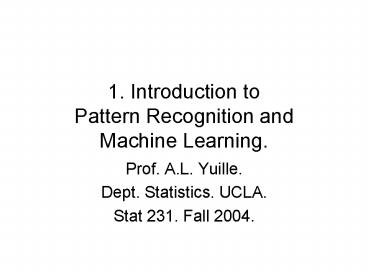1. Introduction to Pattern Recognition and Machine Learning. - PowerPoint PPT Presentation
1 / 19
Title:
1. Introduction to Pattern Recognition and Machine Learning.
Description:
Stat 231 concentrates on Discriminative Methods and simple Generative Models. ... Both Generative and Discriminative methods require training data to learn the ... – PowerPoint PPT presentation
Number of Views:195
Avg rating:3.0/5.0
Title: 1. Introduction to Pattern Recognition and Machine Learning.
1
1. Introduction to Pattern Recognition and
Machine Learning.
- Prof. A.L. Yuille.
- Dept. Statistics. UCLA.
- Stat 231. Fall 2004.
2
Structure.
- Examples of Patterns.
- Discriminate/Decisions about Patterns.
- Schools of Pattern Recognition.
- Learning Theory.
3
What are Patterns?
- Laws of Physics Chemistry generate patterns.
4
Patterns in Astronomy.
- Humans tend to see patterns everywhere.
5
Patterns in Biology.
- Applications Biometrics, Computational Anatomy,
Brain Mapping.
6
Patterns of Brain Activity.
- Relations between brain activity, emotion,
cognition, and behaviour.
7
Variations of Patterns.
- Patterns vary with expression, lighting,
occlusions.
8
Speech Patterns.
- Acoustic signals.
9
Goal of Pattern Recognition.
- Recognize Patterns. Make decisions about
patterns. - Visual Example is this person happy or sad?
- Speech Example did the speaker say Yes or
No? - Physics Example is this an atom or a molecule?
10
Applications of Pattern Recognition.
Handwritten digit/letter recognition Biometrics
voice, iris, fingerprint, face, and gait
recognition Speech recognition Smell recognition
(e-nose, sensor networks) Defect detection in
chip manufacturing Interpreting DNA
sequences Fruit/vegetable recognition Medical
diagnosis Terrorist Detection Credit Fraud
Detection Credit Applications.
11
Two Extreme Approaches
- Generative Methods
- Determine models of how patterns are formed.
- Use these models to perform discrimination.
- Pattern Theory. Grenander.
- Discriminative Methods
- Dont model pattern formation.
- Instead extract features from patterns and
make decision using these features.
12
Example Salmon versus Sea Bass.
- Generative methods attempt to model the full
appearance of Salmon and Sea Bass. - Discriminative methods extract features
sufficient to make the decision (e.g. length and
brightness).
13
Fish Features. Length.
- Salmon are usually shorter than Sea Bass.
14
Fish Features. Lightness.
- Sea Bass are usually brighter than Salmon.
15
Decision Boundaries.
- Classify fish as Salmon or Sea Bass based on a
decision boundary in feature space.
16
Generative Models for Speech.
- Stochastic Grammars for Speech Natural
Language. (Manning Schutze).
17
Bayes Decision Theory
- Bayes Decision Theory gives a framework for
Generative and Discriminative approaches. - Current Wisdom
- (i) Discriminative methods are simpler,
computationally faster, and easier to apply. - (ii) Generative methods are needed for most
complex problems. - Hybrid methods are increasingly popular.
- Stat 231 concentrates on Discriminative Methods
and simple Generative Models. - Other courses by Prof.s Zhu Yuille deal with
complex Generative Models.
18
Learning Theory.
- Both Generative and Discriminative methods
require training data to learn the
models/features/decision rules. - Machine Learning concentrates on learning
discrimination rules. - Key Issue do we have enough training data to
learn?
19
Course Elements.
- Bayes Decision Theory as theoretical basis.
- Simple discriminative and generative methods.
- Machine Learning.
- Advanced Discriminative Methods.































